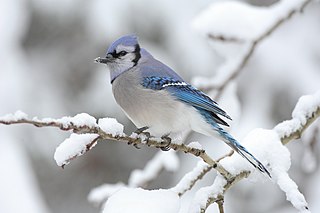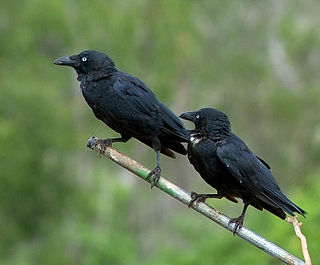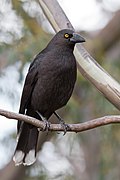
Corvidae is a cosmopolitan family of oscine passerine birds that contains the crows, ravens, rooks, magpies, jackdaws, jays, treepies, choughs, and nutcrackers. In colloquial English, they are known as the crow family or corvids. Currently, 135 species are included in this family. The genus Corvus containing 47 species makes up over a third of the entire family. Corvids (ravens) are the largest passerines.

The Australian magpie is a black and white passerine bird native to Australia and southern New Guinea, and introduced to New Zealand. Although once considered to be three separate species, it is now considered to be one, with nine recognised subspecies. A member of the Artamidae, the Australian magpie is placed in its own genus Gymnorhina and is most closely related to the black butcherbird. It is not closely related to the European magpie, which is a corvid.

The Torresian crow, also called the Australian crow or Papuan crow, is a passerine bird in the crow family native to the north and west of Australia and nearby islands in Indonesia and Papua New Guinea. The species has a black plumage, beak and mouth with white irises. The base of the feathers on the head and neck are white. The Torresian crow is slightly larger with a more robust bill than the morphologically similar little crow.

The grey currawong is a large passerine bird native to southern Australia, including Tasmania. One of three currawong species in the genus Strepera, it is closely related to the butcherbirds and Australian magpie of the family Artamidae. It is a large crow-like bird, around 48 cm (19 in) long on average; with yellow irises, a heavy bill, dark plumage with white undertail and wing patches. The male and female are similar in appearance. Six subspecies are recognised and are distinguished by overall plumage colour, which ranges from slate-grey for the nominate from New South Wales and eastern Victoria and subspecies plumbea from Western Australia, to sooty black for the clinking currawong of Tasmania and subspecies halmaturina from Kangaroo Island. All grey currawongs have a loud distinctive ringing or clinking call.

The black currawong, also known locally as the black jay, is a large passerine bird endemic to Tasmania and the nearby islands within the Bass Strait. One of three currawong species in the genus Strepera, it is closely related to the butcherbirds and Australian magpie within the family Artamidae. It is a large crow-like bird, around 50 cm (20 in) long on average, with yellow irises, a heavy bill, and black plumage with white wing patches. The male and female are similar in appearance. Three subspecies are recognised, one of which, Strepera fuliginosa colei of King Island, is vulnerable to extinction.

The pied currawong is a black passerine bird native to eastern Australia and Lord Howe Island. One of three currawong species in the genus Strepera, it is closely related to the butcherbirds and Australian magpie of the family Artamidae. Six subspecies are recognised. It is a robust crowlike bird averaging around 48 cm (19 in) in length, black or sooty grey-black in plumage with white undertail and wing patches, yellow irises, and a heavy bill. The male and female are similar in appearance. Known for its melodious calls, the species' name currawong is believed to be of indigenous origin.

The bushshrikes are smallish passerine birds. They were formerly classed with the true shrikes in the family Laniidae, but are now considered sufficiently distinctive to be separated from that group as the family Malaconotidae, a name that alludes to their fluffy back and rump feathers.

The Cracticinae, bellmagpies and allies, gathers together 12 species of mostly crow-like birds native to Australasia and nearby areas.

Woodswallows are soft-plumaged, somber-coloured passerine birds in the genus Artamus. The woodswallows are either treated as a subfamily, Artaminae, in an expanded family Artamidae, or as the only genus in that family. The generic name, which in turn gives rise to the family name, is derived from the Ancient Greek artamos, meaning butcher or murder. The name was given due to their perceived similarity to shrikes. A former common name for the group was "swallow-starlings".

The pied butcherbird is a songbird native to Australia. Described by John Gould in 1837, it is a black and white bird 28 to 32 cm long with a long hooked bill. Its head and throat are black, making a distinctive hood; the mantle and much of the tail and wings are also black. The neck, underparts and outer wing feathers are white. The juvenile and immature birds are predominantly brown and white. As they mature their brown feathers are replaced by black feathers. There are two recognised subspecies of pied butcherbird.

Butcherbirds are songbirds closely related to the Australian magpie. Most are found in the genus Cracticus, but the black butcherbird is placed in the monotypic genus Melloria. They are native to Australasia.

Cracticus is a genus of butcherbirds native to Australasia. They are large songbirds, being between 30 and 40 cm (12–16 in) in length. Their colour ranges from black-and-white to mostly black with added grey plumage, depending on the species. They have a large, straight bill with a distinctive hook at the end which is used to skewer prey. They have high-pitched complex songs, which are used to defend their essentially year-round group territories: unlike birds of extratropical Eurasia and the Americas, both sexes sing prolifically.

The black-backed butcherbird is a species of bird in the family Artamidae. It is found in southern New Guinea and Cape York Peninsula.

The black butcherbird is a species of butcherbird in the family Artamidae. It is found in Australia, Indonesia, and Papua New Guinea. Its natural habitats are subtropical or tropical dry forest, subtropical or tropical moist lowland forest, and subtropical or tropical mangrove forest.

The frill-necked monarch is a species of songbird in the family Monarchidae. It is endemic to the rainforests of the northern Cape York Peninsula in Australia.

The Lord Howe currawong, Lord Howe Island currawong or Lord Howe pied currawong, is a large and mainly black passerine bird in the family Artamidae. It is endemic to Lord Howe Island in the Tasman Sea, part of New South Wales, Australia, and is a threatened subspecies of the pied currawong.

Artamidae is a family of passerine birds found in Australia, the Indo-Pacific region, and Southern Asia. It includes 24 extant species in six genera and three subfamilies: Peltopsinae, Artaminae and Cracticinae. Artamids used to be monotypic, containing only the woodswallows, but it was expanded to include the family Cracticidae in 1994. Some authors, however, still treat the two as separate families. Some species in this family are known for their beautiful song. Their feeding habits vary from nectar sucking (woodswallows) to predation on small birds.

Malaconotoidea is a superfamily of passerine birds. They contain a vast diversity of omnivorous and carnivorous songbirds widespread in Africa and Australia, many of which superficially resemble shrikes. It was defined and named by Cacraft and colleagues in 2004 and contains the bushshrikes (Malaconotidae), helmetshrikes (Prionopidae), ioras (Aegithinidae), vangas (Vangidae) and the Australian butcherbirds, magpies, currawongs and woodswallows (Artamidae). Molecular analysis in 2006 added the Bornean bristlehead to the group, though its position in the Malconotoidea is unclear. It was initially thought related to the butcherbirds and woodswallows but now is thought to be an early offshoot.

Kurrartapu johnnguyeni is an extinct species of bird in the Australian magpie and butcherbird family. It was described from Early Miocene material found at Riversleigh in north-western Queensland, Australia. It is the first Tertiary record of a cracticid from Australia. The size of the fossil material indicates that it was similar in size to the living black butcherbird. The generic name is a Kalkatungu language term for the Australian magpie. The specific epithet honours John Nguyen, the father of the senior describer.





















